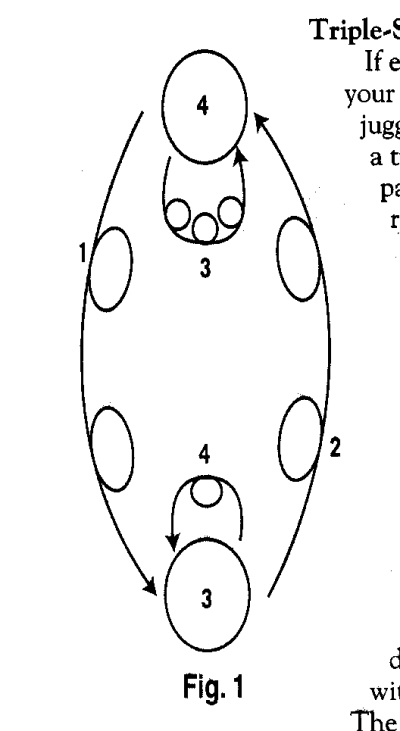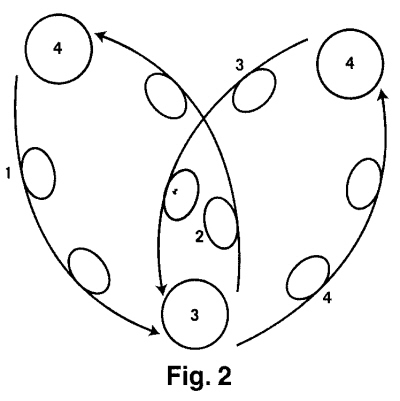|
JUGGLER'S WORKSHOP
Workshops Revisited by Martin Frost
For this 50th anniversary issue, I'm going to remind you of some of the many possibilities in club passing that I've covered in the last 10 years. Included here are extracts from various Juggler's Workshop articles that appeared over that time.
Here are two passing patterns I created in order to get more than two people into a 3-count pattern. These appeared in the Fall 1988 issue, in my first article (under Tips & Tricks) . I still find the 1-Count Typewriter Feed very exhilarating.
3-Count Feed Each of the two feedees in this pattern does a normal 3-ct with the feeder. One feedee starts immediately with a R pass and the second feedee starts with a R self followed by a L pass. Thereafter each feedee passes every 3rd count (alternating R and L). The feeder throws two passes (R then L, one to each feedee), then a self (R), then two passes (L then R, one to each feedee), and then a self (L), before repeating. An easy way to remember the feeder's pattern is to notice that it is two inside passes (R & L), a self, then two outside passes (L & R), and a self. The first of each pair of consecutive passes always goes to the same person, say to the person on the feeder's left (who starts the pattern with a R pass); the second of each pair thus always goes to the person on the right.
1-Count Typewriter Feed This is like the 3-ct feed, but we add a third feedee to get a pass from the feeder on the third count (replacing the feeder's one remaining self). So the feeder here does no selves at all (a 1-ct), passing every club from both hands and going down the row of three people passing exactly one club to each person in turn (alternating passing hands). After the pass to the third person in the row, the next pass goes back to the first person, on the other end - hence the name "typewriter" feed. Each feedee does a normal 3-ct, but the feeder is doing a 1-ct. The challenging part is for the feeder to figure out where the next pass should go (especially if someone drops a club).
From the very first Juggler's Workshop, in the Fall 1989 issue, this section builds to an attention- challenging random feed.
13-Club Feed Of course we can add more feedees to a ten-club feed. With three feedees, we get a 13-club feed, and the feeder has to learn to catch a club coming from a feedee two positions behind where the next pass goes. This can be a little confusing at first, but it's fun when you get in the habit of just catching whatever club shows up near your catching hand. You don't have to figure out where it came from. Maybe try a 13-club feed with singles.
Random 13-Club Feed Now comes the fun when we make the 13- club feed random and thus require strict attention by the feedees, because no one knows what the feeder will do next.
In a normal 13-club feed, the feeder goes down the line and back continually. Each feedee passes back to the feeder one count after a pass from the feeder. In the random feed, the feeder is allowed at each passing beat to pass to any of the feedees. Whoever the feeder passes to has to respond with a return pass. Because there is one count between the feeder's pass and the resulting feedee's pass, it's not hard to respond in time. The feed can move down the the normally or it can jump around. The feeder can even throw in an occasional self triple without disturbing the pattern.
In order to be ready to respond, each feedee should keep an eye on the feeder's passing hand (or body in general) to figure out when a pass will be coming. For starters, it's easier if the feeder doesn't throw two or more passes in a row to the same person, but even that can be handled with some practice.
Here you learn to build up to what we call the T-shirt feed, from the Spring 1991 Workshop.
Triple-Single 4-Count If either you or your partner can juggle four clubs in a triple-single pattern (with the right hand throwing triples to your left and the left throwing singles), try this right-handed passing variation. One person starts with 3 four clubs and alternates double passes with triple selves. The other starts with three clubs and alternates double passes with normal single selves. The whole pattern starts just like seven doubles, with the four-club person passing first (Fig. 1).
This is fairly easy for the person who starts with three. The difficulty is for the four-club juggler to keep the triple selves high and under control while alternating them with lower double passes. The person with three clubs can help out by throwing doubles so that they land about where the triple selves are coming down. You may have to vary the height of the doubles a little to make the timing even for the four-club person (depending on the height of the triples).
Triple-Single 11-Club Feed If we add one more person and four clubs to the above triple-single 4-count, we get an unusual 11-club feed. The person with three clubs in the preceding pattern becomes the feeder and actually has the easiest role, just passing doubles alternately to the two feedees. Each feedee does the same thing as the person with four clubs in the above pattern: alternate between double passes and triple selves.
To start this 11-club feed, one feedee passes a double and the feeder responds one count later with a double to that feedee (just like with only two people). The second feedee starts one count after that, with a double to the feeder. Then everybody just alternates between their two types of throws. The timing of the passes is shown in Fig. 2. For more fun, add more feedees. |

